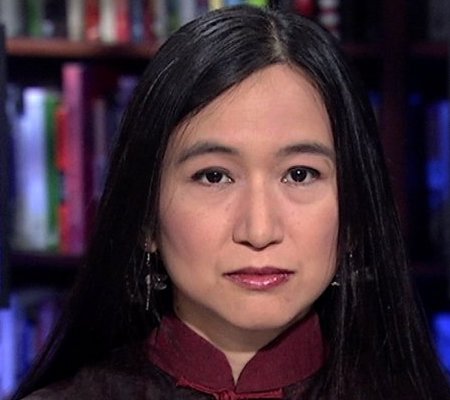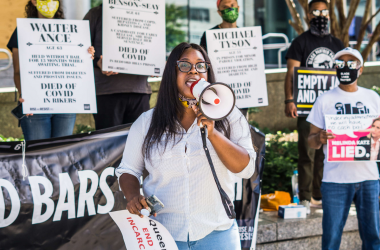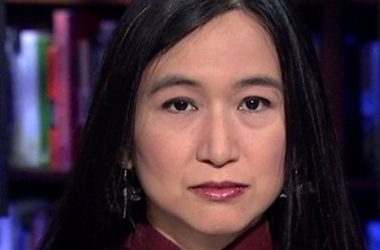Originally posted on Bitch
February 26th, 2018
This story was originally published on October 30, 2014.
It’s time to stock up your bedside table with titles by Black women authors who you can spend the next 11 months reading. Here’s my short list of great authors to introduce you to Black speculative-fiction.
1. Octavia Butler

From left to right: Octavia Butler and Parable of the Sower (Photo credit: Wikimedia Commons/Hachette)
Of course, Octavia Butler tops any list of Black science-fiction and speculative-fiction writers. Her futures are frightening: The characters try to survive in societies governed by right-wing theocracies where alien viruses mutate men into monsters and almost all of humankind has been wiped out by nuclear war. In each of these dystopic scenarios, not only do Black women survive, but they bring with them the seeds of hope and future survival. All of Butler’s books are amazing, but many people really like Parable of the Sower and Parable of the Talents, set in a United States shaken by climate change and governed by a dictatorial theocracy.
If that’s a little too close to reality for your tastes, you could dive into her Xenogenesis trilogy, which starts with humankind nearly wiped out by nuclear war. Survivors, including Lilith Iyapo, are saved by an alien race called the Oankali—they’re tentacled creatures who have three genders (male, female, and ooloi). The Oankali trade in genetics and their rescue of the human race isn’t altogether altruistic. Warning: Butler explores issues of consent and manipulation in her first book Dawn. Some of the outcomes are upsetting. As the trilogy continues, readers see how Lilith’s decisions have affected future generations of humans and ooloi as they navigate a renewed planet.
2. Nalo Hopkinson

Nalo Hopkinson and The Chaos (Photo credit: Wikimedia Commons/Margaret K. McElderry Books)
Readers may remember The Chaos from my Bitch series on Girls of Color in Dystopia. But that’s not the only Nalo Hopkinson book you should read if you love sci-fi and speculative fiction. Some of her books are set in fantastic futures while others take place in fictional places that more closely resemble our own.
New Moon’s Arms, for instance, is set on a fictional Caribbean island. Fifty-something-year-old Chastity has decided to rename herself Calamity and rediscovers her childhood power of finding lost things, including a little boy who washes up on the shore near her house. Like Scotch in The Chaos, Chastity is far from perfect and at times even unlikable. She can be judgmental and closed-minded; for instance, she has trouble accepting gay people, even though her best friend and father of her (now adult) daughter is gay. At times, Chastity hurts him with thoughtless homophobic comments.
But making Calamity real (and sometimes unlikable) is mixed with folklore and magical realism as well. I felt saddened when I finished the book because I had to leave the world that she had created around me.
3. Nnedi Okorafor

Nnedi Okorafor and Binti (Photo credit: Wikimedia Commons/Tor.com)
Imagine a world where magic and technology both exist. Imagine being able to fly, read people you encounter, and also access the internet. Now imagine that future set in the Sahara Desert.
The Shadow Speaker is set in 2070 after Earth has adjusted to life after nuclear fallout. The fallout has brought out magical and mystical abilities in some people while still allowing aspects of technology, such as electricity and internet, to continue working. But not all of the ideas and oppressions of the early 21st century have been eradicated. The story centers on Eeji, who is a “shadow speaker”—a person whom the shadows can speak to. Or, more precisely in Eeji’s case, whom they should be able to speak to but cannot. When Eeji’s father is elected the village’s first chief, he excludes women from learning, requires them to wear burkas and veils, cuts off food and housing programs, and institutes harsh criminal penalties (such as cutting off hands, ears, and occasionally heads). When an earthquake destroys the boundaries between worlds, Eeji has to find a way to keep peace between Earth and the other planets that have long been separated.
4. Karen Lord

Karen Lord and The Best Of All Possible Worlds (Photo credit: Wikipedia/Del Rey)
Set in a future where life exists on multiple worlds, Karen Lord’s book The Best of All Possible Worlds begins with the obliteration of a planet called Sadiri, making the extinction of the planet’s race a real and present danger. (A side note: I read this in the early days of Israel’s attack on Gaza and even though this is fantastic science fiction, Lord’s story felt very relevant.)
The remaining Sadiri arrive at Cygnus Beta, a world where various races meet and cohabit, and begin traveling across the planet to find Sadiri who emigrated generations earlier, with the hope of beginning families and warding off annihilation. Through the main character of Delarua, a scientist and linguist who describes her skin as chestnut brown, we see these different settlements and their people. We see that even in a future with all of its technological and telepathic advances, injustice still exists. In one settlement, readers witness telepathy’s misuse as a form of domestic abuse and control. In another, echoing an American history never referenced in the book, they not only discover the enslavement of an entire race, but also the enslavers’ use of sexual assault to impregnate and thus breed new generations of slaves.
5. N.K. Jemisin

N.K. Jemisin and The Hundred Thousand Kingdoms (Photo credit: Laura Hanifin/Orbit)
At the beginning of the year when I announced my challenge to read 50 books by people of color (I’m on book 46 by the way!) Bitch readers recommended N.K. Jemisin. While waiting for my reserved copies of The Hundred Thousand Kingdoms to oh-so-slowly make their way to my home branch, I found her beautiful short story “The Effluent Engine” in The Mammoth Book of Steampunk.
“The Effluent Engine” takes place in the past, where Haiti has won its independence from France and means to keep it that way. But unlike the historical Haitian revolution, Haitians won their freedom with air balloons, blimps, and dirigibles powered by the steam and gases from the sugarcane distilleries.
Two generations later, a woman named Jessilyn lands in New Orleans. Her mission? To enlist a prominent Creole engineer in transforming the foul-smelling effluence from rum into a fuel that would allow the Haitians to continue to outmaneuver French attempts to re-enslave them. To say more—or even introduce any other characters—would spoil the story, so just read it. The contributors’ bios say that “The Effluent Engine” is Jemisin’s first attempt at writing steampunk. I really hope she writes more.
Buy Resistance Behind Bars:
Buy Don’t Leave Your Friends Behind:




